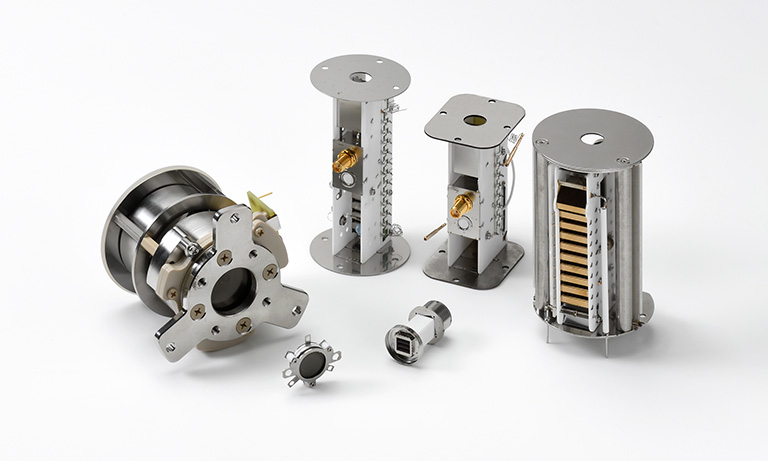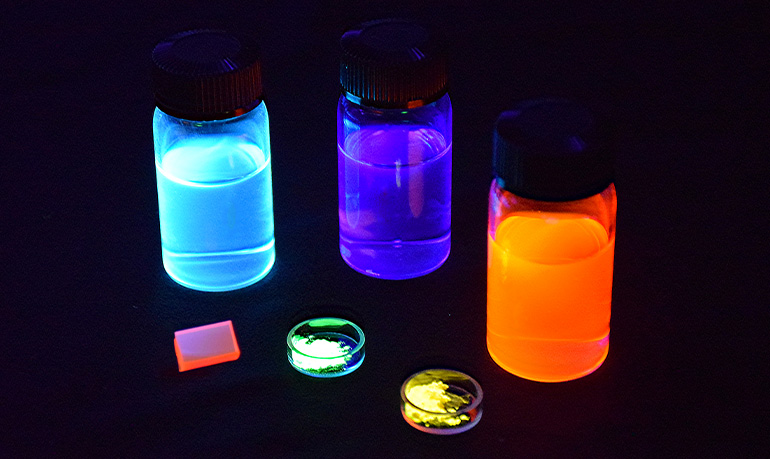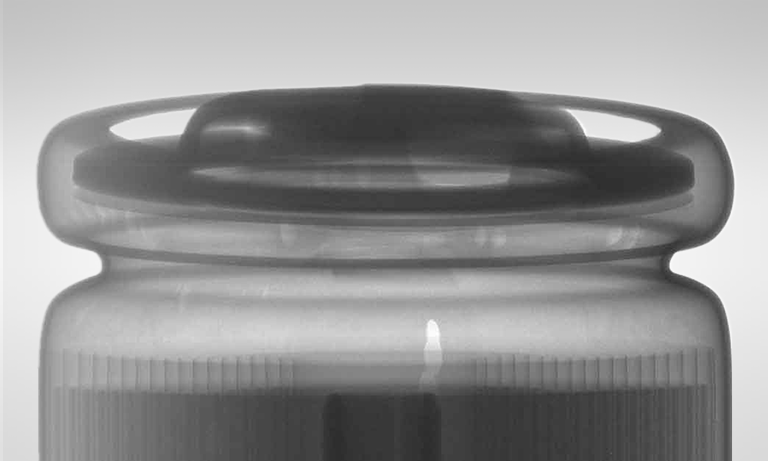United Kingdom (JA)
国・地域を選択してください。
Development of 20-inch PMTs
(Published in July, 2003)
"Hey, could you make me a 25-inch PMT?"
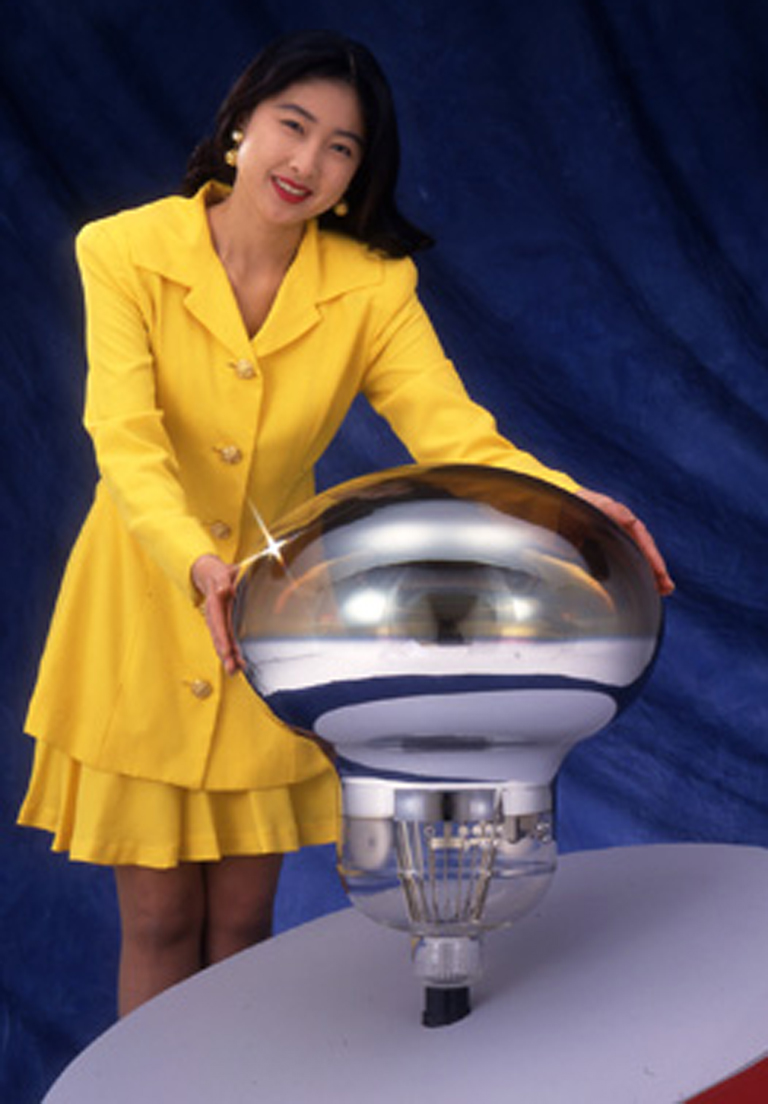
20-inch PMT
In 1979, Masatoshi Koshiba, professor at the Faculty of Science, the University of Tokyo, invited Hamamatsu Photonics (HPK) President Teruo Hiruma to his research laboratory. The purpose of the invitation was for Professor Koshiba to ask President Hiruma to develop large PMTs for use in observing proton decay experiments. Professor Koshiba was a key figure in planning the experiments and the equipment that would be used in them. He came up with a challenging proposal to President Hiruma ----"Hey, could you make me a 25-inch PMT?"
At that time, UK-based Thorn EMI (now Electron Tubes, Ltd.) was busy developing an 8-inch diameter PMT. In spring of that year, HPK had just started work on a prototype PMT with an 8-inch diameter semispherical photocathode envelope. However, what Professor Koshiba was now proposing was on an entirely different scale. The 25-inch diameter PMT he wanted would be about the size of large TV screen.
American scientists were also proceeding with plans for proton decay observation experiments. These plans called for the use of several thousand 5-inch diameter PMTs, which was nearly double the scale of those planned for the Japanese experiment. When Professor Koshiba heard of the American plans, he believed he had to do something to offset the smaller scale Japanese plan. He intended to accomplish this by boosting the sensitivity and accuracy for detecting Cherenkov radiation, which serves as proof of the proton decay process. Proton decay had been predicted in the Grand Unified Theory but, at that time,still had not been proven experimentally.
The making of a 25-inch diameter PMT was an awesome project and accepting the job of developing it was not something to be taken lightly. However, deeply moved by the professor’s zeal and dedication, President Hiruma simply nodded his head and said, "Well, I’ll give it a try." Later that year, HPK began prototype planning.
In the development work, the electron trajectory design was entrusted to HPK’s Electron Tube Group of the Engineering Department, the measurement and evaluation work were handled by the Basic Measurement Group of the Engineering Department, and the overall prototype fabrication was the responsibility of Production Department No.5. After reviewing each evaluation report, the decision was madeto develop a 20-inch PMT.
The proton decay observation experiment had the goal of using PMTs to capture the Cherenkov radiation triggered by the highenergy charged particles that are generated as protons decay. PMTs were designed to have a hemispherical photosensitive surface to easily capture the Cherenkov radiation emissions that come flying from every angle and to maintain good pressure resistance.
Development work was based on the previous 8-inch tube prototypes. Unlike the hemispherical photosensitive area of the 5-inch tubes, the photosensitive area of the 8-inch tube has a slightly flattened hemispherical surface with a cross-section resembling a rugby ball. This was judged the best shape for a 20-inch tube in terms of its excellent time characteristics and photoelectron collection efficiency.
Electron trajectory design had to satisfy the extremely difficult condition of achieving time characteristics within 2 nanoseconds, as well as boosting photoelectron collection efficiency. Work proceeded, with special attention paid to the photoelectron transit time difference from each position of the photocathode to the first dynode (electron multiplying dynode), as well as the incident angle to the first dynode. Though development work did not achieve time characteristics of 2 nanoseconds, it did succeed in designing a prototype with a proven, recorded value of 4 nanoseconds.
The overall structure of the PMT was next in the design process. The photocathode shape and focusing electrode design were the basis for the PMT. Since the PMTs were to be submerged in water for long periods of time in the proton decay experiment, a glass material called HARIO 32 was used as the glass bulb because it has superb water-resistance characteristics. This HARIO 32 is a hard glass with a small thermal expansion coefficient of 32. It had historically been used in applications requiring good heat resistance, such as thermos bottles, microwave ovenware and glass coffee maker parts, but had never been used for a PMT.
Creating the World’s Largest PMT
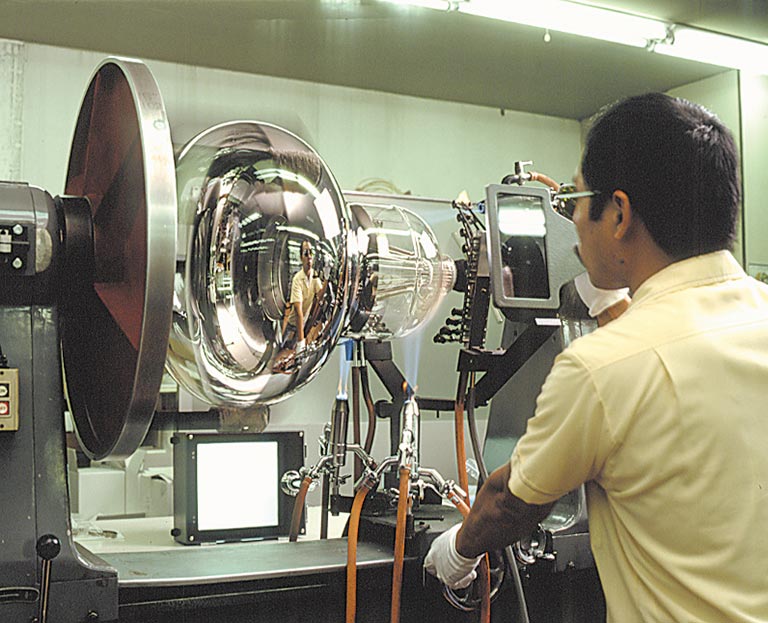
Sealing process of 20 inch PMT
The production of the prototype 20-inch PMT began in October 1980. The most difficult challenge that arose was sealing the glass bulb and stem. So, HPK’s foremost expert in glass processing, who was at that time managing the overall glass fabrication work in Hamamatsu Photonics, was placed directly in charge of this difficult work. A 10-inch diameter sealing mouth with a hard thick walled (4 mm) glass bulb could not be easily fabricated by an ordinary gas burner. Fabricating the sealing mouth required a 10-link hydrogen gas burner, as well as a large-size glass lathe. In conjunction with the gas burner and lathe were two larger burners, which were used for slow cooling. Unfortunately, the high heat needed to seal the mouth also oxidized the dynode, causing the gain to drop.
The slow cooling time was shortened in an attempt to deal with the problem; however, a 5-cm warped section appeared on both sides of the sealing mouth and cracks occurred as a result. The problem was finally solved by making a thinner glass bulb that was a uniform 4-mm thick and modifying the slow cooling method. With this technique, it took approximately one hour to completely seal the mouth, including replacing nitrogen gas.
The HARIO 32’s sturdy and difficult-to-break bulb material made it ideal as a glass material for large tubes. However, with an average thickness of only 4 mm, blowing the glass bulb was an extremely difficult technical feat. The technicians ultimately conquered this problem by sheer effort and experience, allowing a steady supply of tubes to be constantly manufactured.
To determine the PMT properties under water pressure, a large capacity pressure tester was designed. Results from tests revealed that the PMT could withstand more than 8 atmospheres of pressure. The PMT implosion characteristics were also studied in the unlikely event that the PMT was damaged during shipping. Drop tests indicated that the plastic bag covering the unit kept glass fragments from flying but that the sound of the implosion could be heard in the vicinity.
The weight of the electrodes, including the dynodes, was more than 2 kg, which was well beyond that of an ordinary PMT. To reduce costs, the high-priced nonmagnetic stainless steel usually used for PMT electrodes was replaced with less expensive stainless steel, similar to that usually found in kitchen sinks. Also, large Venetian blind-type dynodes measuring 75 x 75 mm were used in the PMT. By making these modifications to the 20-inch tube, an extremely wide field-of-view was achieved with the PMT.
Seven-millimeter wide stainless steel was used to support the electrodes. To further suppress vibration, large plate springs were used to grip the electrodes. The upper part of the wire leads in the stem of the PMT were fastened by a glass ring to boost strength. To enhance anode output uniformity versus the light input position, Venetian blind-type dynodes were installed at positions that were symmetrically spaced from the center of the electrodes. Antimony metal was evaporated on the dynodes using a method proven to give high sensitivity; this yielded effective results. In this way, a number of previously acquired highly sophisticated technologies were collectively used to develop the 20-inch PMT.
HPK’s Production Department No. 6 was responsible for the two-stage process of activating the photocathode. The first stage consisted of baking the tube for two days in order to thoroughly degas it. On the third day, the photocathode was fabricated.
Because this was a 20-inch PMT, the biggest question was whether or not its cathode could be manufactured correctly. The days leading up to the completion of the first PMT were anxious. Moreover, in steps such as antimony evaporation, there was no other recourse but to rely on the eyes and judgment of those professionals performing the tube evacuation task. An ordinary PMT can be held in the worker’s hand throughout the production process, but the large 20-inch PMT first had to be secured in place. Then, the worker could perform his required tasks while walking around the outside of the PMT. The workers donned protective helmets equipped with explosion masks, mounted steps to the platform holding a large pumping bench, and began the final fabrication, which consisted of making the photocathode and sealing the PMT.
The color formed from oxygen discharge in the photocathode manufacturing process was visually attractive. When made to react with potassium after antimony evaporation, the tint immediately changed to an ideal color for a photocathode. Cheers arose from the staff gathered around the pumping bench, as it was a moment of high emotion for everyone.
A 4-inch oil diffusion pump was used for the first time in the pumping bench. Initially, the activation furnace consisted of a lateral stationary furnace in two sections. During actual production, the PMT was installed in a standing position and a vertical-type electric furnace was used. The finished PMTs were then covered with a metal net for safety and moved by crane.
Usually, the conditions required for photocathode activation during PMT development are extremely hard to determine and can only be found through repeated trial and error. However, the very first 20-inch PMT succeeded in exceeding the goal of 20% quantum efficiency at 400 nanometers. The gain of the second tube exceeded one million. At this point, most of the development work was complete. It should be noted that of the many prototype photomultiplier tubes that Hamamatsu Photonics has developed over the years, it is extremely unusual to produce such good results within the first few tubes produced.
To evaluate the tube characteristics, a large dark box containing a monochromator and LED was used to make measurements. The initial figures for anode sensitivity uniformity were poor, so the shape of the first and second dynodes were changed, as was their arrangement. Improved performance was immediately realized.
The initial request from the scientists at the University of Tokyo stressed that the tubes' time characteristics were the critical factor. However, during the latter half of development, strong demands were made for improving resolution of single photoelectrons to discriminate between electrons and muons. The collection efficiency of the Venetian blind-type dynodes at that time was low, so the signal was small. In that respect, the tube device characteristics could not be called satisfactory. When the PMT was cooled to the water temperature used in actual operation, the dark current dropped and the signal-to-noise ratio improved to an acceptable level. During development of the 20-inch PMTs used in the large scale "Super-Kamiokande" experiment facility in later years, these two characteristics were greatly improved.
Twenty Prototypes in Only Five Months
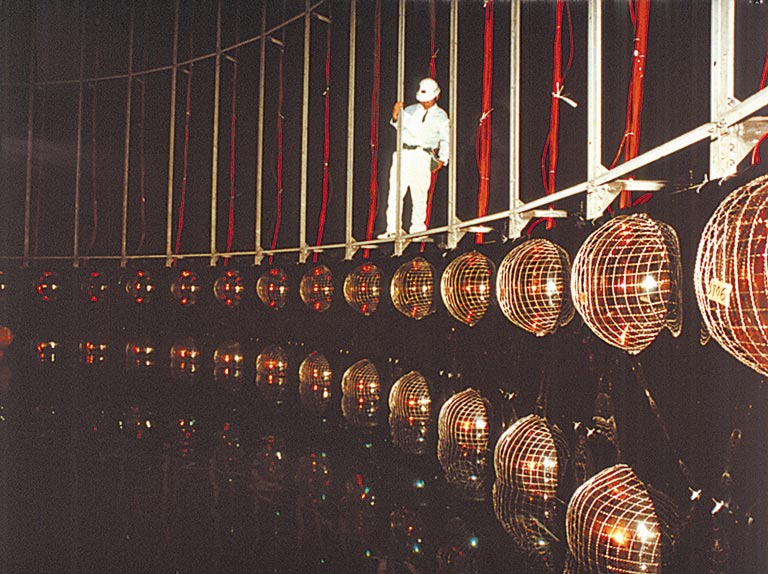
Photomultiplier tubes mounted at Kamiokande.
(Courtesy of ICRR, University of Tokyo)
The first prototype tubes were delivered to the University of Tokyo in January 1981. Actual development ended the following month. There were 20 initial prototype tubes, and their development and manufacture required only five months. The public announcement of these 20-inch PMTs, which were given the model name R1449, was made by the High Energy Physics Research Laboratory at the University of Tokyo.
Main production of the R1449 began in this manner. Production was entrusted to a team of approximately 30 experienced HPK employees in the company’s Production Department No. 7 at the Toyooka Factory.
Initial production was beset by troubles, such as bulb cracks caused by deformation and a drop in gain. Yield gradually increased, and finally reached an average of 70 %, which was a high figure. Production was completed in May of that year.
In May 1982, Hamamatsu Photonics delivered 1,050 of the world’s largest 20-inch PMTs to "Kamiokande" (Kamioka Nucleon Decay Experiment) observatory of the Institute for Cosmic Ray Research. The Institute was established in the Kamioka mine in the town of Kamioka-cho, Yoshiki-gun, Gifu Prefecture, Japan.
These R1449 tubes were mounted in the walls, floor and ceiling on the inner surface of the giant water tank located in a mine 1,000 meters below ground. These 1,000 large eyes quietly continue watching for Cherenkov radiation in order to capture the instant that proton decay occurs.
The Beginning of Neutrino Astronomy
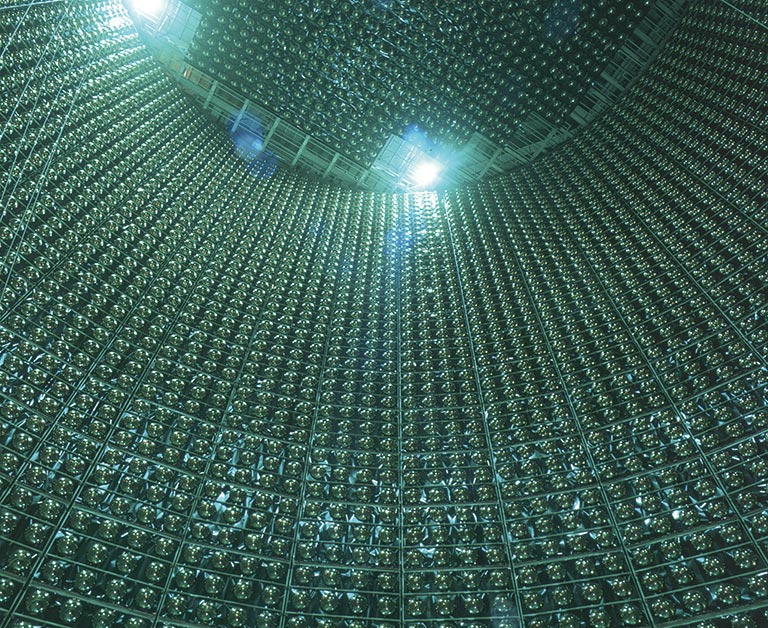
Super Kamiokande (SK)
(Courtesy of ICRR, University of Tokyo)
Some months after observation started, Professor Koshiba was able to confirm that high quality data far exceeding initial expectations was being acquired with the equipment. One important result was that this data attested to the high performance of the R1449 PMTs developed by Hamamatsu Photonics. Another result was that the highly sensitive detection of Cherenkov radiation at Kamiokande showed possibilities for being able to detect solar neutrinos, as well as proton decay. Professor Koshiba then began to make plans for modifying the equipment. These modifications mainly involved adding and enhancing the data analysis equipment used for analyzing the Cherenkov radiation captured by the R1449 PMTs.
The modifications were completed in late 1986. In January 1987 the Kamiokande not only observed proton decay but also neutrinos generated from the nuclear fusion reaction occurring internally in the sun. This equipment was designed to receive the extremely rare Cherenkov radiation produced when neutrinos flying out from the sun passed through the water tank of Kamiokande filled with 3,000 tons of pure water. Of course, the R1449 PMTs acted as essential sensors for this equipment.
Besides being emitted when nuclear fusion occurs in the sun, neutrinos are also released in large numbers from the colossal explosion that occurs when a star dies out. This observation had been gaining much attention as a possible means to unlock the riddles concerning the creation of the universe and its evolution. However, neutrinos are strong enough to pass through materials, including the earth, so that observing them has long been extremely difficult. Because the Kamiokande observatory is buried deep within the earth to avoid the noise of the various cosmic rays bombarding the earth, it is capable of detecting neutrinos and muons. In this way, while simultaneously continuing to await the instant of proton decay, Kamiokande was detecting solar neutrinos at a rate of once every nine days.
One day, completely unexpected news was announced from Kamiokande. At 4:35 PM on the afternoon of February 23, 1987, Kamiokande detected neutrinos traveling far from a supernova (1987A) that emerged out in a corner of the Large Megallanic Cloud some 170,000 light years from the Earth. Supernova explosions are said to occur only once every several hundred years. Capturing this event was an extremely great stroke of good fortune, as the last time such an event could be seen by the naked eye was in 1604.
On that day in 1987, 10 billion neutrinos rained down on each square centimeter and an estimated 2 x 1016 neutrinos bombarded the entire tank. Of all those neutrinos, only 11 caused Cherenkov radiation to be emitted due to collisions with the electrons in the water-filled tank. This was the first time neutrinos from a supernova could be observed and this event announced the beginning of "neutrino astronomy" for probing the universe with elementary particles.
These were truly great results for Hamamatsu Photonics. By continuing to operate correctly underwater for a four-year period, the world’s largest PMTs installed within the water tank demonstrated that they could operate just as expected and were further able to help write a new page in the science of astronomy history book.
What made this successful event all the more meaningful to those who were involved was that the observation occurred a mere one month before Professor Koshiba was scheduled for retirement.
Super-Kamiokande: Focus of Exciting New Future Prospects
Though its initial objective of observing proton decay was not achieved, Kamiokande did succeed in making man’s first neutrino observation. Its experiment equipment had proved very effective in measuring neutrinos, so though its short name of "Kamiokande" remained unchanged, the official name was revised from "Kamioka Nucleon Decay Experiment" to "Kamioka Neutrino Detection Experiment." The University of Tokyo then announced its "Super-Kamiokande" (A Large Water Cherenkov Detector for Cosmic Particles) plans in August of that same year.
This plan was derived from the impact of a prediction in the mainstream "Grand Unified Theory" that states protons have a life span of 1034 years. This prompted planning for proton decay and neutrino observation equipment with performance upgraded some 10 to 100 times higher than that of Kamiokande. Planning called for construction to be completed by 1995 with a total budget up to approximately 8.7 billion yen. This Super-Kamiokande was constructed in the Kamioka mine about 1,000 meters underground and 900 meters away from Kamiokande. The gigantic water tank of 39.3 meters in diameter and 41.4 meters in height was filled with 50,000 tons of pure water, or approximately 16 times the amount used at Kamiokande.
Hamamatsu Photonics accepted an order for 11,200 20-inch PMTs for use in Super-Kamiokande. The R1449 PMTs were further improved upon and delivered as 20-inch tubes with the model name R3600-05.
Masatoshi Koshiba, Professor Emeritus at the University of Tokyo, was awarded the Nobel Prize in Physics “for pioneering contributions to astrophysics, in particular for the detection of cosmic neutrino."
He succeeded in observing neutrinos made by a supernova explosion in February 1987 with Kamiokande, which is the predecessor of Super-Kamiokande. We offer our deepest congratulations.
- Confirmation
-
It looks like you're in the . If this is not your location, please select the correct region or country below.
You're headed to Hamamatsu Photonics website for GB (Japanese). If you want to view an other country's site, the optimized information will be provided by selecting options below.
In order to use this website comfortably, we use cookies. For cookie details please see our cookie policy.
- Cookie Policy
-
This website or its third-party tools use cookies, which are necessary to its functioning and required to achieve the purposes illustrated in this cookie policy. By closing the cookie warning banner, scrolling the page, clicking a link or continuing to browse otherwise, you agree to the use of cookies.
Hamamatsu uses cookies in order to enhance your experience on our website and ensure that our website functions.
You can visit this page at any time to learn more about cookies, get the most up to date information on how we use cookies and manage your cookie settings. We will not use cookies for any purpose other than the ones stated, but please note that we reserve the right to update our cookies.
1. What are cookies?
For modern websites to work according to visitor’s expectations, they need to collect certain basic information about visitors. To do this, a site will create small text files which are placed on visitor’s devices (computer or mobile) - these files are known as cookies when you access a website. Cookies are used in order to make websites function and work efficiently. Cookies are uniquely assigned to each visitor and can only be read by a web server in the domain that issued the cookie to the visitor. Cookies cannot be used to run programs or deliver viruses to a visitor’s device.
Cookies do various jobs which make the visitor’s experience of the internet much smoother and more interactive. For instance, cookies are used to remember the visitor’s preferences on sites they visit often, to remember language preference and to help navigate between pages more efficiently. Much, though not all, of the data collected is anonymous, though some of it is designed to detect browsing patterns and approximate geographical location to improve the visitor experience.
Certain type of cookies may require the data subject’s consent before storing them on the computer.
2. What are the different types of cookies?
This website uses two types of cookies:
- First party cookies. For our website, the first party cookies are controlled and maintained by Hamamatsu. No other parties have access to these cookies.
- Third party cookies. These cookies are implemented by organizations outside Hamamatsu. We do not have access to the data in these cookies, but we use these cookies to improve the overall website experience.
3. How do we use cookies?
This website uses cookies for following purposes:
- Certain cookies are necessary for our website to function. These are strictly necessary cookies and are required to enable website access, support navigation or provide relevant content. These cookies direct you to the correct region or country, and support security and ecommerce. Strictly necessary cookies also enforce your privacy preferences. Without these strictly necessary cookies, much of our website will not function.
- Analytics cookies are used to track website usage. This data enables us to improve our website usability, performance and website administration. In our analytics cookies, we do not store any personal identifying information.
- Functionality cookies. These are used to recognize you when you return to our website. This enables us to personalize our content for you, greet you by name and remember your preferences (for example, your choice of language or region).
- These cookies record your visit to our website, the pages you have visited and the links you have followed. We will use this information to make our website and the advertising displayed on it more relevant to your interests. We may also share this information with third parties for this purpose.
Cookies help us help you. Through the use of cookies, we learn what is important to our visitors and we develop and enhance website content and functionality to support your experience. Much of our website can be accessed if cookies are disabled, however certain website functions may not work. And, we believe your current and future visits will be enhanced if cookies are enabled.
4. Which cookies do we use?
There are two ways to manage cookie preferences.
- You can set your cookie preferences on your device or in your browser.
- You can set your cookie preferences at the website level.
If you don’t want to receive cookies, you can modify your browser so that it notifies you when cookies are sent to it or you can refuse cookies altogether. You can also delete cookies that have already been set.
If you wish to restrict or block web browser cookies which are set on your device then you can do this through your browser settings; the Help function within your browser should tell you how. Alternatively, you may wish to visit www.aboutcookies.org, which contains comprehensive information on how to do this on a wide variety of desktop browsers.
5. What are Internet tags and how do we use them with cookies?
Occasionally, we may use internet tags (also known as action tags, single-pixel GIFs, clear GIFs, invisible GIFs and 1-by-1 GIFs) at this site and may deploy these tags/cookies through a third-party advertising partner or a web analytical service partner which may be located and store the respective information (including your IP-address) in a foreign country. These tags/cookies are placed on both online advertisements that bring users to this site and on different pages of this site. We use this technology to measure the visitors' responses to our sites and the effectiveness of our advertising campaigns (including how many times a page is opened and which information is consulted) as well as to evaluate your use of this website. The third-party partner or the web analytical service partner may be able to collect data about visitors to our and other sites because of these internet tags/cookies, may compose reports regarding the website’s activity for us and may provide further services which are related to the use of the website and the internet. They may provide such information to other parties if there is a legal requirement that they do so, or if they hire the other parties to process information on their behalf.
If you would like more information about web tags and cookies associated with on-line advertising or to opt-out of third-party collection of this information, please visit the Network Advertising Initiative website http://www.networkadvertising.org.
6. Analytics and Advertisement Cookies
We use third-party cookies (such as Google Analytics) to track visitors on our website, to get reports about how visitors use the website and to inform, optimize and serve ads based on someone's past visits to our website.
You may opt-out of Google Analytics cookies by the websites provided by Google:
https://tools.google.com/dlpage/gaoptout?hl=en
As provided in this Privacy Policy (Article 5), you can learn more about opt-out cookies by the website provided by Network Advertising Initiative:
http://www.networkadvertising.org
We inform you that in such case you will not be able to wholly use all functions of our website.
Close











